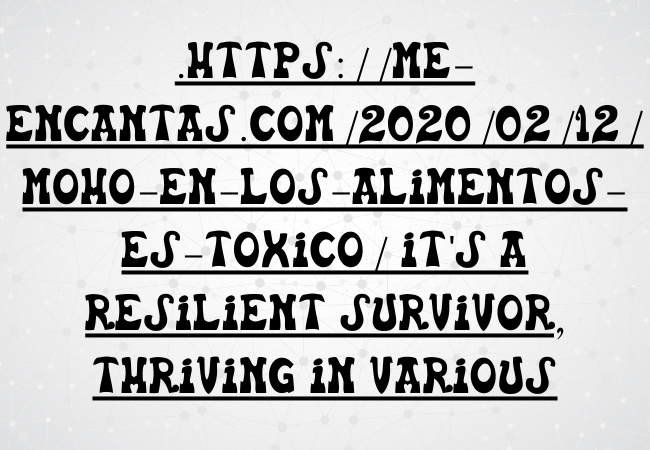Https://me-encantas.com/2020/02/12/moho-en-los-alimentos-es-toxico/

Mold, the silent invader, creeps into our lives, often without notice. It finds refuge in the corners of our bread, the surfaces of our fruits, and the depths of our refrigerators. But what is this elusive organism, and should we fear it? Dive with me into the enigmatic world of mold on food, where we’ll uncover its secrets and discern its true nature.
What Is Mold?
Mold is a type of fungus that exists almost everywhere.Https://me-encantas.com/2020/02/12/moho-en-los-alimentos-es-toxico/ It’s a resilient survivor, thriving in various environments, especially where moisture and organic material are present. When it comes to food, mold manifests in different forms, each with unique characteristics and potential health implications.
The Nature of Mold
Molds are microscopic fungi, forming multicellular filaments called hyphae. These hyphae grow and spread, producing spores that become airborne, seeking new places to colonize. Mold is nature’s recycler, breaking down organic matter and contributing to the ecosystem.
Common Types of Mold Found on Food
Not all molds are created equal. The most common types include:
- Penicillium: Often found on bread and cheese, it can be blue, green, or white.
- Aspergillus: Typically appears on starchy foods like bread and potatoes.
- Cladosporium: Usually dark green or black, found on meat and dairy products.
How Does Mold Grow on Food?
Mold growth on food requires specific conditions, including warmth, moisture, and organic material. The lifecycle of mold begins with spore germination, followed by hyphal growth, and ultimately, spore production.
Conditions Favoring Mold Growth
Mold flourishes in damp, warm environments. It can quickly colonize food left out at room temperature or stored improperly. Humidity accelerates its growth, making our kitchens a prime target.
The Lifecycle of Mold
From spore to colony, mold’s lifecycle is a fascinating journey. Spores land on a suitable surface, germinate, and produce hyphae. These hyphae spread, forming a network that can be visible to the naked eye. As the colony matures, it produces new spores, continuing the cycle.
Is Mold Always Toxic?
The toxicity of mold depends on the type and the presence of mycotoxins. These toxic compounds can pose significant health risks, but not all mold produces them.
Understanding Mycotoxins
Mycotoxins are secondary metabolites produced by certain mold species Https://me-encantas.com/2020/02/12/moho-en-los-alimentos-es-toxico/. They can cause various health issues, from acute poisoning to long-term effects like cancer. Common mycotoxins include aflatoxins and ochratoxins.
The Difference Between Harmful and Harmless Mold
While some molds are harmless and even beneficial (like those used in cheese production), others can be detrimental to health. Recognizing the type of mold is crucial in determining its safety.
Common Foods Prone to Mold
Certain foods are more susceptible to mold growth due to their composition and storage conditions.
Bread and Baked Goods
Bread is a prime target for mold due to its moisture and nutrient content. Once mold appears, it’s best to discard the entire loaf to avoid health risks.
Fruits and Vegetables
Fruits and vegetables with high water content are also prone to mold. Visible mold on the surface often indicates deeper contamination.
Dairy Products
Dairy products like cheese and yogurt can harbor mold, which may produce harmful mycotoxins. Moldy dairy should be discarded to prevent illness.
Signs of Mold on Food
Detecting mold early can prevent consumption and potential health issues.
Visual Indicators
Mold can appear as fuzzy spots, ranging in color from white to green, blue, or black. Any visible mold should be a red flag.
Smell and Texture Changes
Moldy food may emit a musty odor and exhibit texture changes, such as softness or slime. These signs indicate contamination.
Health Risks of Consuming Moldy Food
Eating moldy food can lead to various health problems, some of which can be severe.
Short-Term Effects
Short-term effects of consuming mold include nausea, vomiting, and allergic reactions. Some molds produce toxins that cause acute poisoning.
Long-Term Health Consequences
Long-term exposure to mycotoxins can lead to chronic health issues, including respiratory problems, weakened immune systems, and even cancer.
Can You Eat Around Mold?
While it may be tempting to salvage moldy food by cutting away the affected area, this is not always safe.
When It’s Safe to Cut Away Mold
Hard foods like cheese and firm fruits may be salvaged by cutting away the moldy part, ensuring a wide margin. However, caution is advised.
Foods That Should Be Discarded Entirely
Soft and porous foods, such as bread, should be discarded Https://me-encantas.com/2020/02/12/moho-en-los-alimentos-es-toxico/entirely when mold is present, as the mold can penetrate deeper than visible.
Preventing Mold Growth on Food
Proper food storage and handling can significantly reduce the risk of mold.
Proper Storage Techniques
Store food in airtight containers and refrigerate perishables promptly. Use food within its shelf life to minimize mold growth.
The Role of Temperature and Humidity
Keeping your kitchen cool and dry helps prevent mold. Use a dehumidifier if necessary and avoid leaving food out at room temperature for extended periods.
What to Do If You Accidentally Eat Mold
Accidentally consuming mold can be alarming, but there are steps you can take.
Immediate Steps to Take
If you realize you’ve eaten moldy food, rinse your mouth and drink water. Monitor for symptoms like nausea or allergic reactions.
When to Seek Medical Attention
Seek medical attention if you experience severe symptoms such as difficulty breathing, persistent nausea, or vomiting.
The Emotional Impact of Mold on Food
Mold can be more than just a physical issue; it can also have emotional repercussions.
The Disappointment of Wasted Food
Finding mold on food can be disheartening, especially when it means wasting what was meant to nourish you.
Coping with Food Safety Concerns
Awareness and education about mold can help mitigate fears and promote safer food handling practices.
The Science Behind Mold Removal
Removing mold effectively requires understanding what works and what doesn’t.
Effective Methods to Remove Mold
For non-porous surfaces, cleaning with vinegar or baking soda can remove mold. However, food items with mold should generally be discarded.
Common Myths About Mold Removal
Contrary to popular belief, scraping off mold does not always make food safe. Mold roots can penetrate deeply, making the entire food item unsafe.
Environmental Factors Influencing Mold Growth
Mold growth is influenced by various environmental factors, including seasonal changes and climate conditions.
Seasonal Variations
Certain seasons, particularly humid ones, promote mold growth. Be extra vigilant during these times to prevent contamination.
The Impact of Climate Change
Climate change, with its impact on temperature and humidity, may Https://me-encantas.com/2020/02/12/moho-en-los-alimentos-es-toxico/contribute to increased mold growth in certain regions.
Frequently Asked Questions About Mold on Food
Can All Types of Mold Make You Sick?
Not all molds are harmful, but it’s best to err on the side of caution and avoid consuming moldy food.
How Can You Tell If Mold Is Dangerous?
It’s challenging to determine mold’s danger without laboratory testing. Visible mold should generally be considered unsafe.
What Are the Most Common Symptoms of Mold Exposure?
Symptoms can include nausea, vomiting, respiratory issues, and allergic reactions.
Is Mold in the Refrigerator Different from Mold at Room Temperature?
Mold can grow in both environments, though it may grow slower in the refrigerator. Both types can be harmful.
Can You Get Sick from Breathing in Mold?
Yes, inhaling mold spores can cause respiratory problems and allergic reactions, especially in sensitive individuals.
Conclusion
Mold on food is a complex issue that intertwines health, safety, and emotions. By understanding its nature and taking preventive measures, we can safeguard our health and reduce food waste. Stay Https://me-encantas.com/2020/02/12/moho-en-los-alimentos-es-toxico/informed, stay safe, and remember: when in doubt, throw it out.



